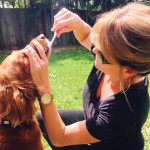Knowing how to perform CPR on an animal is a must for every pet owner. There are certain emergency situations where action is required immediately. Keep in mind that it only takes three minutes for an animal that is not breathing to develop permanent brain damage. Some information found on the internet on how to perform pet CPR is not totally accurate and with pet CPR techniques modified every few years for efficiency it’s easy to understand why there is so much confusion. Note that the animal must be unconscious; a weak pet that has collapsed but is conscious has the potential to bite due to fear or pain or both. It’s also important to point out that CPR will not be effective on animals that show cardiac-respiratory arrest due to chronic diseases, such as cancer or cardiac conditions:
BASIC PET CPR
- Recognize that the pet is unconscious. If the pet is unconscious he/she will not be responsive, the pupils will be dilated, there will be no respiration, the gums will be blueish, and there will be a very weak or nonexistent heartbeat. If the pet seems unconscious but you are not sure if it is breathing or if there is a heartbeat, initiate CPR anyway.
- Initiate Artificial Respiration. Quickly place the pet on a firm surface with the right side of the body down and the head aligned with the spine. Open the mouth and look for any object that might be blocking the air passages and remove it if present. Pull the tongue out of the mouth and let it hang on the side. Gently close the muzzle with your hand. Make an airtight seal by surrounding the pet’s nose (or the whole muzzle if it’s a small dog or cat) with your lips, then blow in the nostrils for 2 seconds, pause, and repeat once more.
- Initiate cardiac compressions. Place one hand on each side of the chest at the level of the animal’s heart (this is the point where the elbow comes in contact with the chest when you flex the pets elbow and shoulder all the way towards the back). For cats and little dogs, perform the compressions with just one hand, fingers on one side of the chest and the palm of the hand on the other side, as if squeezing a squeaky toy. Compress the chest 30 times at a rhythm of two compressions per second. (To make this task easier, follow the rhythm of the Bee Gees 1983 hit song “Staying Alive” in your mind.)
- Maintain the respiration-cardiac compression cycles. Perform two artificial respirations followed by 30 cardiac compression cycles for ten minutes. Check every one-to-two minutes to see if the pet is breathing on its own and/or has a heartbeat. Remember to be patient; in a best case scenario, it will take at least a minute for your compressions to successfully bring blood into the heart and for you to start noticing signs of improvement such as pink gums. Your chest compressions are not as efficient as a natural cardiac compression. They only produce 30 percent of the cardiac output produced by a natural heartbeat, so be persistent while performing the respiration-compression cycles.
You must take your pet to the nearest emergency clinic after ten minutes, even if you feel you were successful performing the CPR technique. Animals that have gone into cardiac or respiratory arrest need further medical care to assure their survival. The most important thing to remember is to stay calm, analyze the situation and take immediate action. You might save your best friends life one day.










 Deering Estate
Deering Estate
 Massage Envy South Miami
Massage Envy South Miami
 Calla Blow Dry
Calla Blow Dry
 My Derma Clinic
My Derma Clinic
 Sushi Maki
Sushi Maki
 Sports Grill
Sports Grill
 The Healthy Kitchen
The Healthy Kitchen
 Golden Rule Seafood
Golden Rule Seafood
 Malanga Cuban Café
Malanga Cuban Café

 Kathleen Ballard
Kathleen Ballard
 Panter, Panter & Sampedro
Panter, Panter & Sampedro
 Vintage Liquors
Vintage Liquors
 The Dog from Ipanema
The Dog from Ipanema
 Rubinstein Family Chiropractic
Rubinstein Family Chiropractic
 Your Pet’s Best
Your Pet’s Best
 Indigo Republic
Indigo Republic




 ATR Luxury Homes
ATR Luxury Homes


 2112 Design Studio
2112 Design Studio
 Hamilton Fox & Company
Hamilton Fox & Company
 Creative Design Services
Creative Design Services
 Best Pest Professionals
Best Pest Professionals
 HD Tree Services
HD Tree Services
 Trinity Air Conditioning Company
Trinity Air Conditioning Company
 Cisca Construction & Development
Cisca Construction & Development
 Mosquito Joe
Mosquito Joe
 Cutler Bay Solar Solutions
Cutler Bay Solar Solutions


 Miami Royal Ballet & Dance
Miami Royal Ballet & Dance
 Christopher Columbus
Christopher Columbus
 Pineview Preschools
Pineview Preschools
 Westminster
Westminster
 Carrollton
Carrollton
 Lil’ Jungle
Lil’ Jungle
 Frost Science Museum
Frost Science Museum
 Palmer Trinity School
Palmer Trinity School
 South Florida Music
South Florida Music
 Pinecrest Orthodontics
Pinecrest Orthodontics
 Dr. Bob Pediatric Dentist
Dr. Bob Pediatric Dentist
 d.pediatrics
d.pediatrics
 South Miami Women’s Health
South Miami Women’s Health

 The Spot Barbershop
The Spot Barbershop
 My Derma Clinic
My Derma Clinic




 Miami Dance Project
Miami Dance Project

 Rubinstein Family Chiropractic
Rubinstein Family Chiropractic
 Indigo Republic
Indigo Republic

 Safes Universe
Safes Universe
 Vintage Liquors
Vintage Liquors
 Evenings Delight
Evenings Delight





 Atchana’s Homegrown Thai
Atchana’s Homegrown Thai
 Baptist Health South Florida
Baptist Health South Florida

 Laser Eye Center of Miami
Laser Eye Center of Miami
 Visiting Angels
Visiting Angels
 OpusCare of South Florida
OpusCare of South Florida

 Your Pet’s Best
Your Pet’s Best





 HD Tree Services
HD Tree Services
 Hamilton Fox & Company
Hamilton Fox & Company


 Creative Design Services
Creative Design Services